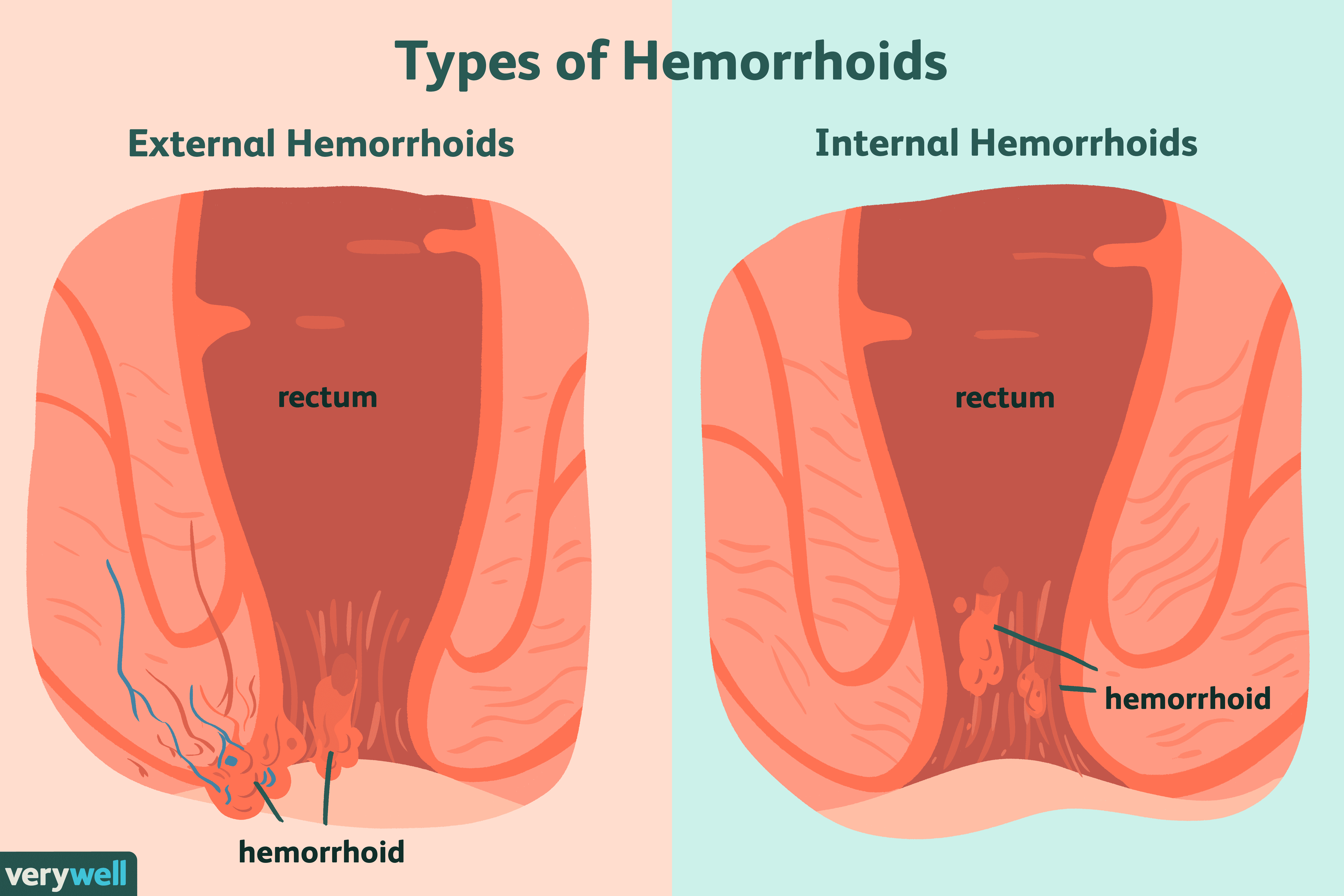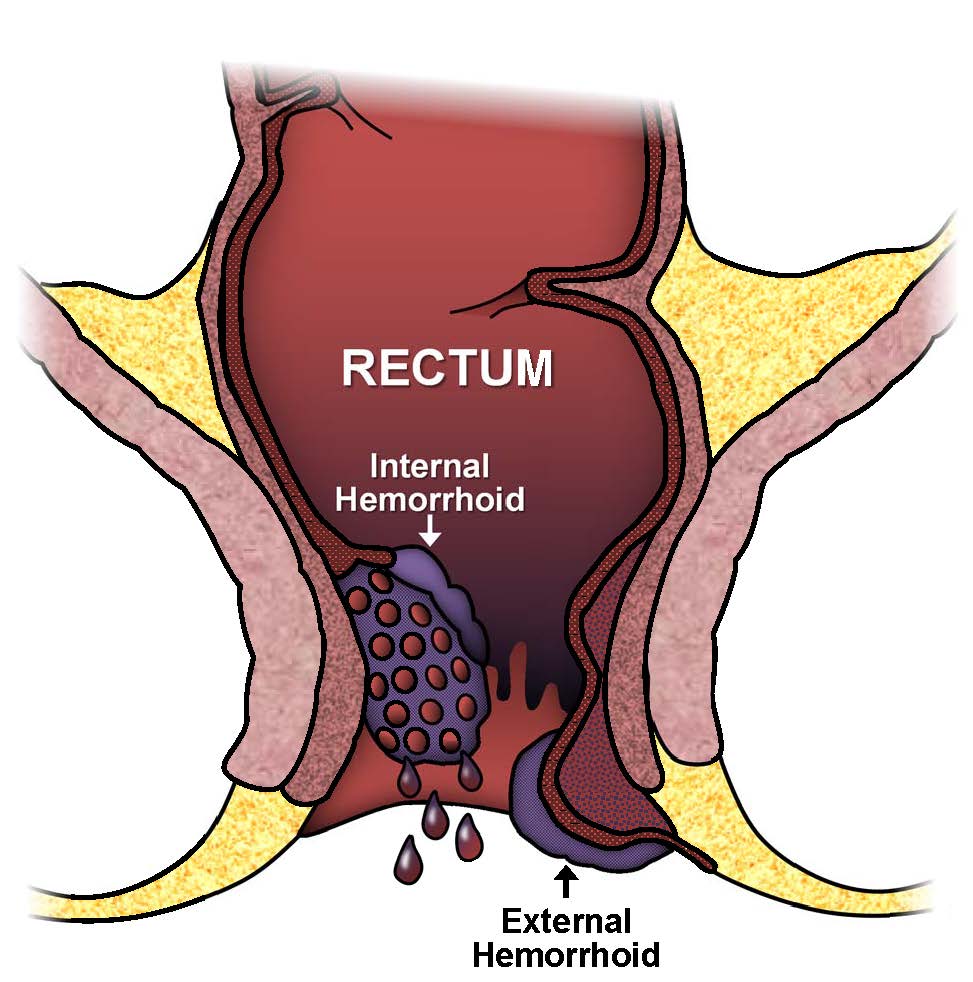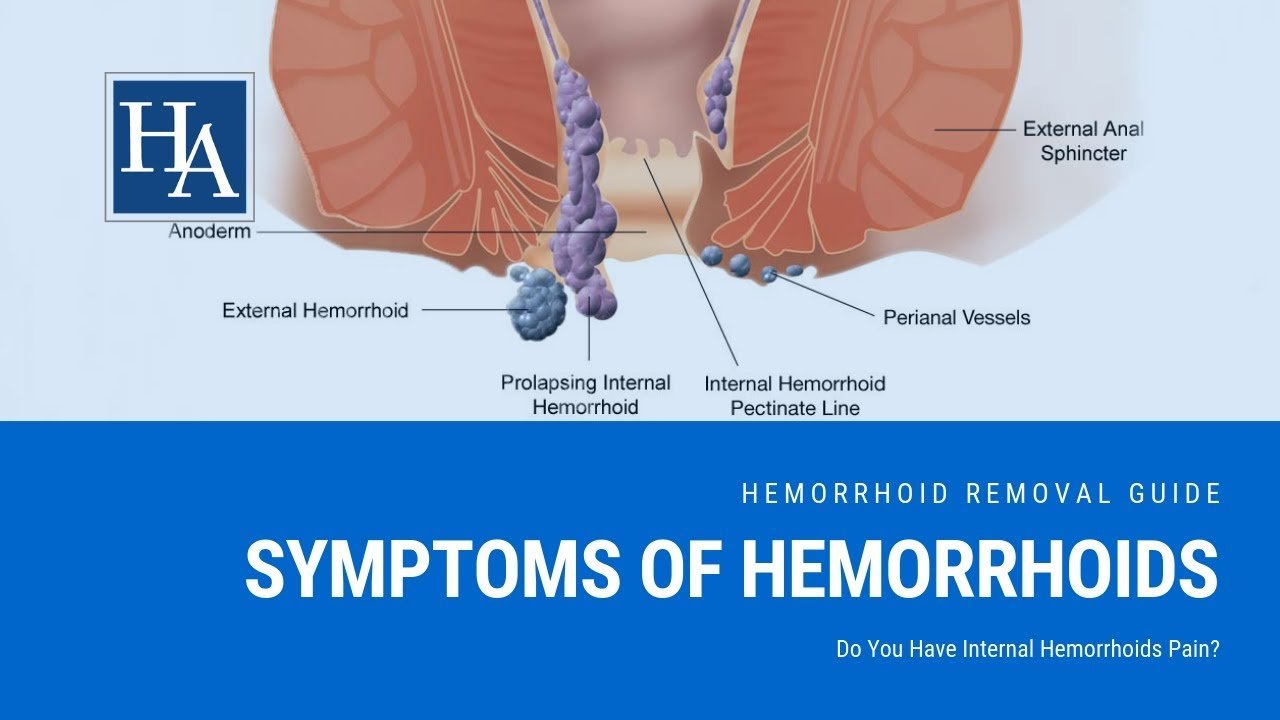What Are The Different Signs Of Internal Hemorrhoids
Signs of internal hemorrhoids can vary. Symptoms associated with hemorrhoids usually consist of bleeding, itchiness, and perhaps some pain. Knowing the signs that are regularly linked to internal hemorrhoids might help determine whether there is a potential cause for the condition. When in doubt, it may be wise to seek medical attention and undergo a physical examination.
The anal passage is comprised of several sections of blood vessels. Their purpose is to help preserve normal bowel function throughout a person’s life. Due to a number of causes, the blood vessels can become inflamed, causing hemorrhoids.
Two types of hemorrhoids exist. Internal hemorrhoids develop in the rectum, the upper portion of the anal passage. If hemorrhoids are produced in the lower area of the anal passage, they are referred to as external. The signs of internal hemorrhoids can be somewhat similar to those of their external counterparts, but in some cases, internal hemorrhoids might go unnoticed since it is possible to feel no symptoms at all.
Signs Your Hemorrhoids Warrant A Doctor’s Visit
Your doctor may also check for blood in the stool, examine the muscle tone of your anus, and perform a rectal exam to diagnose internal hemorrhoids. This is done in the doctor’s office with a gloved, lubricated finger and an anoscope . Your doctor may also recommend additional tests to rule out other causes of bleeding, especially if you are over age 40.
How To Get Rid Of Piles
Banding treatmentBanding is the most commonly used piles treatment, especially for grade 2 and 3 piles. It may also be done to treat grade 1 piles which have not settled with the simple advice and treatment outlined above.
This procedure is usually done by a surgeon in an outpatient clinic. A haemorrhoid is grasped by the surgeon with forceps or a suction device. A rubber band is then placed at the base of the haemorrhoid. This cuts off the blood supply to the haemorrhoid which then dies and drops off after a few days. The tissue at the base of the haemorrhoid heals with some scar tissue.
Banding of internal piles is usually painless, as the base of the haemorrhoid originates above the anal opening in the very last part of the gut where the gut lining is not sensitive to pain.
In about 8 in 10 cases, the piles are cured by this technique. In about 2 in 10 cases, the piles come back at some stage. Piles are less likely to come back after banding if you do not become constipated and do not strain on the toilet .
A small number of people have complications following banding, such as bleeding, infection or ulcers forming at the site of a treated haemorrhoid, or urinary problems.
Injection sclerotherapyPhenol in oil is injected into the tissues at the base of the piles. This causes a scarring reaction which obliterates the blood vessels going to the piles. The piles then die and drop off, similar to after banding.
Recommended Reading: How To Check For Hemorrhoids
Medicines For Treating Piles
Theres a range of medicines that can help to relieve the symptoms of piles. Always read the patient information leaflet that comes with your medicine and ask your pharmacist for advice if you have any questions.
- If youre passing hard poo, a fibre supplement such as ispaghula husk or mild laxative such as lactulose will soften it.
- Over-the-counter painkillers, such as paracetamol, may help to ease any pain from piles. Dont take painkillers that have an opioid in them , as these could make you constipated and add to your problems.
- Soothing creams, ointments and suppositories may ease any pain and itchiness from piles. There are lots of different products available over the counter. Some contain a local anaesthetic such as lidocaine. Only use these for a few days as they may affect the sensitivity of your skin ask your pharmacist for more information.
- Products that contain corticosteroids, such as Anusol HC and Proctosedyl, may reduce swelling and pain. Dont use these for more than a week as they can damage the skin around your anus. Most are available over the counter and others on prescription.
It can sometimes take up to a month for self-help measures and medicines to work. If your symptoms dont improve after this time, contact your GP. They may refer you to a specialist.
Do I Need Colonoscopy For My Hemorrhoids

In most cases, you will not need a colonoscopy to diagnose, stage, or treat your hemorrhoids. However, in some cases you may need this type of screening test to rule out other possible causes of your symptoms. During a colonoscopy, the doctor uses a long, flexible tube with a camera on the end to look at your colon and check for issues with your lower gastrointestinal tract.
Also Check: What Causes Hemorrhoids In Males
The Only Way To Know With Certainty Is To Ask A Doctor
Whether youre feeling excess tissue around the anus or youre seeing a small amount of blood on the toilet paper, your symptoms may indicate a hemorrhoid problem. If youre still uncertain about whether you should see a doctor about your symptoms read out blog post titled Do I have to see my doctor if my hemorrhoids are bleeding?. Since the only way to know is to call a doctor near you and schedule a consultation, we recommend you search our database for a doctor near you that offers the CRH ORegan treatment. The CRH ORegan System is the only non-invasive, quick procedure designed to treat the source of your symptoms.
Heal Your Hemorrhoids
Keep Your Bowels Moving
“The most important thing is to make sure you’re not constipated and having to bear down when you go to the bathroom,” Ramas says. Constipation can both lead to hemorrhoid flare-ups and make them last longer.
Drink plenty of fluids, preferably water — not alcohol and caffeine. These tend to dehydrate, which is the opposite of what you want.
“I found out that dairy was a huge culprit for me,” Adams says, “so I cut it out a little bit, and I had good results.”
Add fiber to your diet with fresh fruit, leafy green vegetables, whole grains, and bran. “It’s about fueling your body appropriately and giving yourself the nutrients that your body needs to function effectively,” Ramas says. Your doctor might also want you to take psyllium husk supplements.
Exercise can help keep you regular, too.
And when you feel the need to go, don’t wait. “You want to have a bowel movement as quickly and efficiently as possible,” she says.
Adams used a foot stool that wraps around the toilet to put her in a squatting position. “It’s like an ergonomic way to poop,” Ramas says. “If that helps some people, that’s definitely OK.”
Recommended Reading: Can Hemorrhoids Make You Feel Sick
Signs Your Hemorrhoids Require Medical Intervention
You may, understandably, not like to talk about it, but hemorrhoids are pretty common. They affect about 10 million adults in the United States annually. Its estimated, in fact, that as many as three in four adults will experience problems with hemorrhoids at some point in their lives.
Take a walk down the pharmacy aisle at your local grocery store and youll likely find plenty of treatments that promise to help. But what do you do when home remedies dont work? Is there a medical treatment that will help heal your hemorrhoids and resolve your pain?
Yes, says Dr. Betsy Clemens. And the good news? Effective hemorrhoid treatment doesnt always mean surgery. In fact, most of the time it does not.
Dr. Clemens leads our team here at Midwest Hemorrhoid Treatment Center in Creve Coeur, Missouri. Shes a specialist who is well known for her medical expertise as well as her passion for making her patients feel comfortable when addressing this sometimes embarrassing condition.
Hemorrhoids 10 Symptoms To Watch For
Hemorrhoids are swollen veins at the bottom of the rectum or anus. When healthy, these veins assist with the elimination of stool, but if they swell and stretch, protruding from the rectum, they can cause pain and itching.Increased pressure in the lower rectum is the primary cause of hemorrhoids, often the result of prolonged sitting, poor diet, constipation, obesity, or pregnancy. Adults 45 to 65 are most likely to get hemorrhoids, but anyone can develop them.Swelling veins inside the rectum are called internal hemorrhoids, while those that develop under the skin around the anus are called external hemorrhoids.
Recommended Reading: How To Get Rid Of Inner Hemorrhoids
What Makes Piles More Likely
There are certain situations that increase the chance of piles developing:
- Constipation, passing large stools , and straining at the toilet. These increase the pressure in and around the veins in the anus and seem to be a common reason for piles to develop.
- Being overweight. This increases your risk of developing piles.
- Pregnancy. Piles are common during pregnancy. This is probably due to pressure effects of the baby lying above the rectum and anus, and also the affect that the change in hormones during pregnancy can have on the veins. Piles occurring during pregnancy often go away after the birth of the child.
- Ageing. The tissues in the lining of the anus may become less supportive as we become older.
- Hereditary factors. Some people may inherit a weakness of the wall of the veins in the anal region.
- Other possible causes of piles include heavy lifting or a persistent cough.
Symptoms Of Thrombosed External Hemorrhoids
External hemorrhoids can be felt as bulges at the anus, but they usually cause few of the symptoms that are typical of internal hemorrhoids.
External hemorrhoids can cause problems, however, when blood clots inside them. This is referred to as thrombosis. Thrombosis of such a hemorrhoid causes an anal lump that is
- very painful,
- tender, and
- often requires medical attention.
The thrombosed hemorrhoid may heal with scarring, and leave a tag of skin protruding in the anus. Occasionally, the tag is large, which can make anal hygiene difficult or irritate the anus. Even after such a hemorrhoid goes away, a residual skin tag may remain, and this may need to be surgically removed.
Also Check: Can You Get Hemorrhoids Removed
Can A Bowel Movement Be Caused By Hemorrhoids
All people have hemorrhoids we are all born with hemorrhoids. Not everyone, however, has hemorrhoid causing symptoms. When these hemorrhoids become enlarged, you may have painless rectal bleeding. Swelling of hemorrhoids may cause them to prolapse during a bowel movement. How are internal hemorrhoids treated?
What Questions Should I Ask My Doctor

You may want to ask your healthcare provider:
- Why did I get hemorrhoids?
- What is the best treatment for me?
- What lifestyle changes can I make to keep from getting hemorrhoids again?
- When will symptoms improve?
- Should I look out for signs of complications?
A note from Cleveland Clinic
An estimated 15 million Americans have sought treatments for hemorrhoids at some point in their lives. But many more suffer needlessly. Dont be too embarrassed to talk to your healthcare provider about your symptoms. If hemorrhoids cause pain or discomfort, your provider has treatments that can help. You can also take steps to keep hemorrhoids from coming back.
Last reviewed by a Cleveland Clinic medical professional on 01/18/2021.
References
Don’t Miss: What To Do With Hemorrhoids During Pregnancy
The Most Common Symptom Of Internal Hemorrhoids Is Bleeding
Internal hemorrhoids form when blood vessels inside the rectum become swollen and engorged. Although they form in the lowest part of the rectum, internal hemorrhoids are still far enough inside you may not even know that theyre there. In fact, everyone actually has internal hemorrhoids, but we only notice them once they become a problem. Internal hemorrhoids can worsen over time, but since there are very few pain-sensing nerves in the lower rectal area, you are unlikely to feel any pain. In fact, the most common symptoms of mild internal hemorrhoids is bleeding. You can read more about hemorrhoid bleeding on our blog: here. However, when internal hemorrhoids become moderate to severe, you will likely begin to experience those hard-to-ignore hemorrhoid symptoms.
How Do Internal Hemorrhoids Look Like
One usually can’t see or feel internal piles, and they rarely cause discomfort unless your doctor diagnoses it. You might neglect simple and minor symptoms, but during bowel movements /Straining at the toilet, one can notice bright red blood in the toilet or tissue paper.
One can also notice lumps that bulge outside the anus.These lumps are usually pinker than the surrounding area & these are often referred to as prolapsed internal hemorrhoids.
Read Also: What Is The Best Home Treatment For Hemorrhoids
Avoid Constipation And Straining At The Toilet
Keep the stools soft, and don’t strain on the toilet. You can do this by:
- Eating plenty of fibre .
- Have lots to drink. Most sorts of drink will do but too much alcohol and caffeine should be avoided.
- Fibre supplements. If a high-fibre diet is not helping, you can take fibre supplements such as ispaghula, methylcellulose, bran or sterculia.
- Avoid painkillers that contain codeine, such as co-codamol, as they are a common cause of constipation. However, simple painkillers such as paracetamol may help.
- Toileting. Go to the toilet as soon as possible after feeling the need. Do not strain on the toilet.
- Regular exercise helps to reduce constipation.
These measures will often ease piles symptoms such as bleeding and discomfort. It may be all that you need to treat small and non-prolapsing piles . Small grade 1 piles often settle down over time.
See the separate leaflets called Constipation, Constipation in Children and Fibre and Fibre Supplements for more information.
What Are The Signs And Symptoms Of Internal Hemorrhoids
Signs and symptoms might include: Internal hemorrhoids lie inside the rectum. You usually cant see or feel them, and they rarely cause discomfort. But straining or irritation when passing stool can cause: Painless bleeding during bowel movements. You might notice small amounts of bright red blood on your toilet tissue or in the toilet.
Read Also: How Do You Fix Hemorrhoids
When To See A Doctor
Blood in the stool is never normal and should always be discussed with a physician, even when it is thought to be from a hemorrhoid.
Blood in the stool is most often the result of hemorrhoids bright red blood is characteristic. Stools that have darker red blood or that appear tarry might be related to another condition, particularly one associated with an area higher up in the digestive tract. In the event of these symptoms, it might be necessary to have testing to rule out other conditions.
Hemorrhoids Doctor Discussion Guide
Profuse rectal bleeding thats accompanied by feelings of faintness or dizziness is a reason to seek medical attention right away.
This type of bleeding is not typical for hemorrhoids and may be an indication that another problem is occurring. Similarly, mucus or pus from the rectum, fever, chills, nausea, or a rapid heartbeat arent common symptoms of a hemorrhoid and are also a reason to seek medical care right away.
What Natural Home Remedies Soothe Or Cure Hemorrhoids
Hemorrhoid symptoms of pain and itching can be treated at home by doing the following.
Warm Sitz Baths
- Sitting in a few inches of warm water three times a day for 15 to 20 minutes may help decrease the inflammation of the hemorrhoids.
- It is important to dry off the anal area completely after each Sitz bath to minimize irritation of the skin surrounding the anus.
Dietary Changes
- Increased fluid intake and dietary fiber will decrease the potential for constipation and lessen the pressure on the rectum and anus during a bowel movement, minimizing further swelling, discomfort, and bleeding. Dietary fiber supplements also may help bulk up the stools
Stool Softeners
- Stool softeners may help. A health-care professional or a pharmacist are good resources to discuss their use.
Exercise
- Individuals with hemorrhoids should not sit for long periods of time and may benefit from sitting on an air or rubber donut available at most local pharmacies.
- Exercise is helpful in relieving constipation and in decreasing pressure on the hemorrhoidal veins. Individuals should be encouraged to have a bowel movement as soon as possible after the urge arises and not sit on the toilet for long periods of time. Once that urge passes, stools can become constipated and straining with a bowel movement may occur.
Recommended Reading: Who Do You See About Hemorrhoids
What Are Possible Complications Of Piles
A possible complication of piles that hang down is that they can ‘strangulate’. This means that the blood supply to the pile has been cut off. A blood clot can form within the pile. This causes really severe pain if it occurs. The pain usually reaches a peak after 48-72 hours and then gradually goes away over 7-10 days.
Hemorrhoid Home Remedies: Warm Sitz Bath

A sitz bath refers to sitting in a few inches of warm water three times a day for 15 to 20 minutes. A sitz bath may help decrease the inflammation of hemorrhoids. Drying off the anal area completely after each sitz bath is important for minimizing moisture that irritates the skin surrounding your rectal area.
Read Also: Can Adults Use Desitin For Hemorrhoids
Where Are Hemorrhoids Located In The Human Body
What are internal hemorrhoids? A hemorrhoid is a cushion of blood vessels in the lining of the anal canal. All people have hemorrhoids we are all born with hemorrhoids. Not everyone, however, has hemorrhoid causing symptoms. When these hemorrhoids become enlarged, you may have painless rectal bleeding.